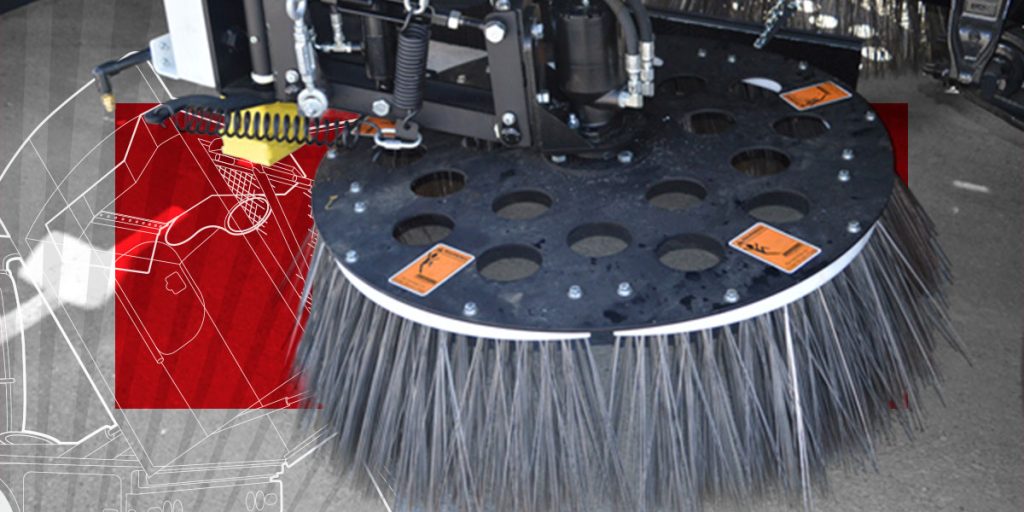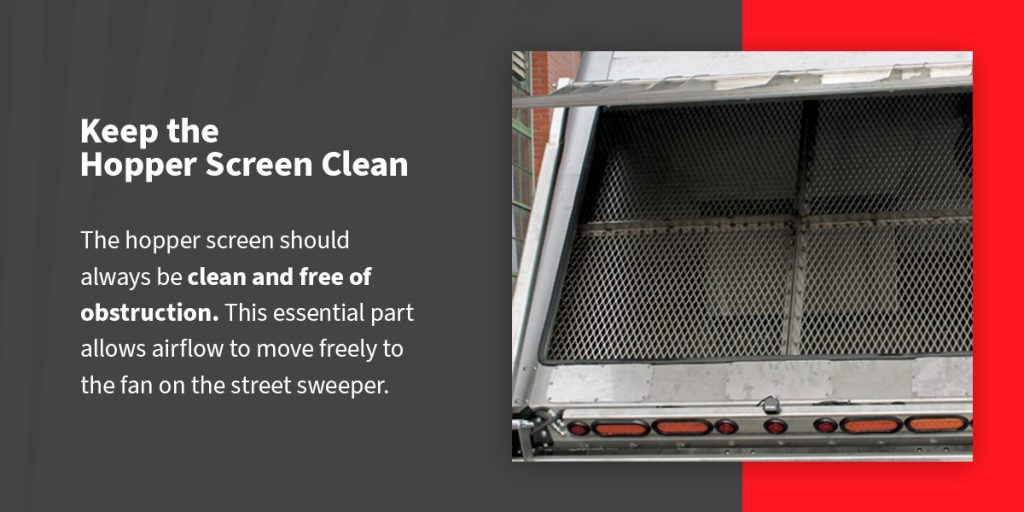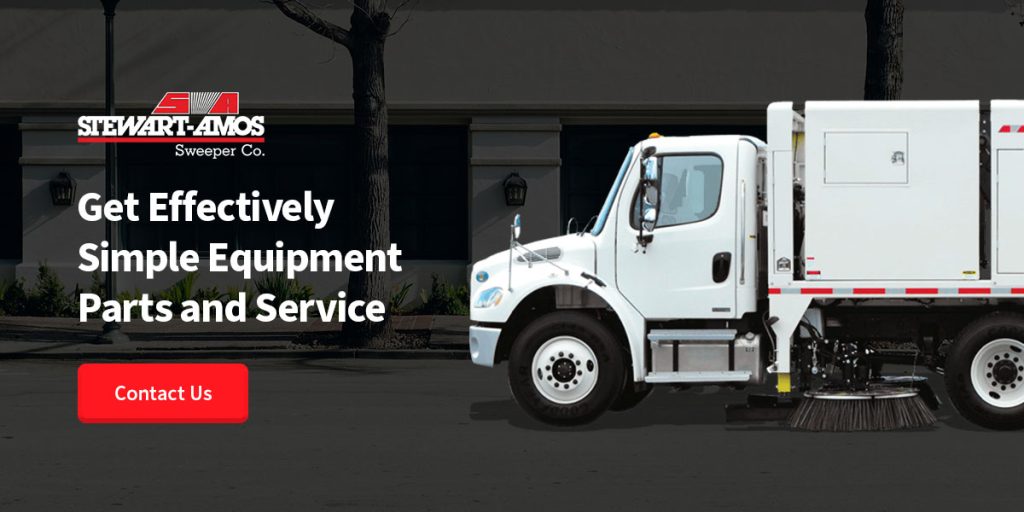
Whether you are new to the street sweeping industry or an expert who has owned these machines for decades, you should know that the most critical aspect of operating any type of equipment is performing preventative maintenance. As with other heavy machinery, street sweepers perform challenging and dirty jobs day in and day out.
If you neglect your machine, you will likely have to replace and repair parts more often and even buy a new machine sooner than you would like. In this sweeper truck maintenance guide, we will teach you how to perform preventative care for your machine and keep it at maximum productivity at all times.
Importance of Regular Sweeper Care
The better you maintain your street cleaning equipment, the longer it will be operable and efficient. Here are some of the top benefits of street sweeper maintenance:
- Reduced repairs: By regularly inspecting, cleaning and caring for your parts, you most likely will not have to repair them as often, which can be a cost-effective solution for many owners.
- Enhanced longevity: As with automobiles and other machines, performing a street sweeper tune-up frequently can extend the life span of your street sweeper and allow you to use it for years to come.
- Fewer interruptions and breakdowns: Dealing with disruptions while performing your job can be a hassle for you and your community. With fewer breakdowns, you can be more confident in your machine’s capabilities.
- Cleaner communities: By reducing time-consuming repairs and unpredictable issues that lead to inefficient operations, your business can stay on track with your street maintenance services.
10 Tips for Street Sweeper Maintenance
Follow our street sweeper maintenance checklist to ensure your machine is in top condition for each use:
1. Perform Essential Functions
When operating any heavy machinery or equipment that undergoes daily usage, it is vital to frequently perform a street sweeper inspection to examine the overall condition of your machine and determine whether all essential functions are working properly.
This includes checking your engine fluids, tire pressure, vehicle lights, hoses, safety equipment and water filters. You should also inspect your machine for leaks, loose bolts, dents, cracks or other damage before operating.
2. Remove Dirt Buildup in the Debris Hopper
Cleaning your debris hopper daily is important to prevent dirt accumulation. Over time, too must dirt, dust and moisture can create rust on the machine and restrict the airflow, leading to reduced performance. Making a habit of cleaning this part daily will allow you to do your job without constant interruptions and may even speed up the overall process.
3. Keep the Hopper Screen Clean
The hopper screen should always be clean and free of obstruction. This essential part allows airflow to move freely to the fan on the street sweeper. By neglecting this area or allowing dirt to pile up over days or weeks, you may experience issues with the fan. Remove and thoroughly clean the screen and dust separator every few months. While inside the hopper, check the suction inlet liner and dust separator for wear and ensure the door closes properly with a tight seal.

4. Check the Fan and Fan Inlet
The fan and fan inlet are important components of your street sweeper because they help create low pressure inside the machine. This low pressure allows the equipment to remove dirt, debris and garbage from the streets. Inspect the fan and fan inlet daily to look for any type of buildup that could lead to vibration.
Too much buildup can cause driveline and bearing damage. At first signs of machine vibration, you should replace the fan, along with the bearings and driveline, to keep everything up to date and working at its best.
5. Inspect Air Seals
The seals on your street sweeper should always be kept in the best condition possible. These rubber seals are associated with the machine’s fan inlet, suction hose inlet and hopper doors.
A tight seal is critical for vacuum pickup power, so you should always keep air seals well lubricated with a petroleum product and replace them routinely to maintain resilience. To extend the life of the air seals, leave all inspection doors open and raise the hopper a few inches so the seals can regain their optimal shape.
6. Examine and Adjust the Sweeping Head
The sweeping head is perhaps the most essential component on your machine. This part allows operators to efficiently collect dust, dirt, garbage and debris on the street. If the sweeping head becomes unaligned or needs adjustment, it can be extremely difficult to collect dirt and cause a drastic decline in performance.
The sweeping head may become twisted, bent or damaged, which you may not even notice if you do not inspect it regularly. Though this part can be difficult to adjust, it is critical that the sweeping head and rubber skirts are aligned.
7. Check the Rubber Skirts
The rubber skirts are another component you should examine daily. These parts should reach and seal to the ground to help with the vacuum function. If they are not sealing well to the ground or appear to have excessive wear or damage, you should replace them promptly to ensure your street sweeper can collect debris.
8. Test the Curb Brooms
The curb brooms are probably the most identifiable part of your street sweeper. They perform the necessary function of moving debris and dirt from the street curb to the direction of the sweeping head. Over time, the curb brooms can wear or accumulate buildup around the motor shaft.
Excessive dirt in this area can damage the motor seal and the strike pattern. Checking and cleaning this area daily can help prevent damage and maintain optimum strike pattern settings. Replacing the bristles and adjusting the strike pattern on the curb brooms can also help these parts stay in working condition for longer.
9. Monitor the Hydraulic System
As with all types of heavy machinery and operating equipment, the hydraulic system is vital for all major functions of your street sweeper. From the brush and fan rotation to the linear motion for positioning and dumping, this system handles it all. Monitoring and maintaining the hydraulic system involves using the correct viscosity oil, changing the hydraulic filter and checking pressure settings.
If you keep track of these elements regularly, you can identify weak or inoperative hydraulic components as soon as they appear or cause hydraulic pressure loss. To ensure consistent, high performance, replace the hydraulic filter as needed to avoid oil contamination and keep the pressure at ideal levels to help with hydraulic flow.
10. Inspect the Water System
The water system is equally critical as the hydraulic system, so you should conduct a thorough check of the water and dust control components. This system is essential to keeping the fan clear of debris and dusty conditions by maintaining moisture and preventing dirt from sticking to the hopper screen.
Check and clean the water pre-filter and inspect all spray tips to check whether they are functioning properly. Inspect for clogs in the system and ensure the water pump is flowing out at the correct pressure. Repair or replace any inoperable components so you can keep dust under control and maintain optimal performance.

Get Effectively Simple Equipment Parts and Service With Stewart-Amos Sweeper Co.
Keeping your street cleaning equipment well-maintained and in optimal working order can be a challenging task. Whether you need to make several repairs, replace worn-out parts or add new brushes to your inventory, Stewart-Amos has everything you need. We offer an extensive array of brooms and sweeper parts to keep your machines in top shape and eliminate time-consuming repairs.
Our components are easy to maintain, so you can spend more time getting the job done instead of going back and forth between maintenance and repairs. At Stewart-Amos Equipment Co., we are committed to providing our customers with high-quality, reliable and trustworthy equipment that operators can use in many sweeper truck applications.
To learn more about our products and set up a demo, contact us today or browse our equipment online.
